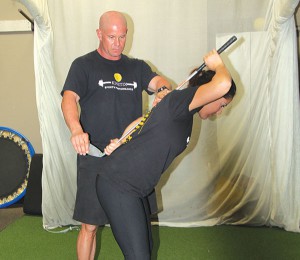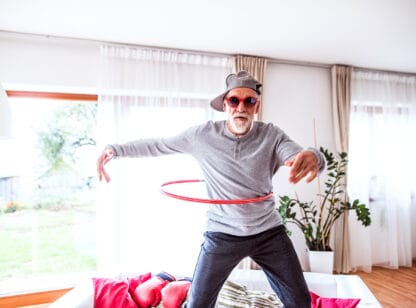
Bending from the hips helps alleviate injury and empowers your golf swing.
Posture is something we all need to consciously work on – especially when it comes to our golf game.
Ideally, if we stand tall, our shoulders, hips, knees and ankles are all in one straight line from our ears. However, many of us spend most of our time sitting for hours which puts our spines and hips through tremendous stress. Unless you can maintain an upright posture and sit straight at all times, you are going to experience pain and stiffness in the joints – just from sitting! Because most of the time when we are sitting at the computer or reading a book, we are slumped forward. However, the body is designed to naturally keep the eyes focused on the horizon, so when slumped forward, the muscles are going to compensate to make sure that the eyes stay focused: the upper back is going to slouch, the lower back is going to tuck underneath us, and additional stress will be placed on the spine and hips.
Your posture for golf takes a concerted effort as well. As we know, the golf stance is not natural due to the different planes of motion and the constant bending and twisting that we put our bodies through. So when we bend forward to address the ball, we should be bending from the hip joints not the back. Many older golfers bend from their backs causing spasms, strains and sprains from repeated overuse. It is critical for a good golf swing – and for your overall health – to have a straight spine and bend from the hips, as it allows your body to turn and relieve stress from the joints.
Unfortunately, as we age, getting used to a new golf stance is difficult and takes time, especially if you have been playing for years. Adhering to a regular exercise regimen that also addresses flexibility and stability can be advantageous and worth the extra money and time to alleviate back pain and injury.
Research shows that approximately 33% of most amateur golfers have “C” posture, which is a rounded back appearance while 25% have “S” posture which is too much spinal curve. These are pretty high percentages! Both of these postures can cause swing faults – especially a disconnect between upper to lower body ratios which can cause the ball to be hit either fat or thin. The key is to perform corrective exercises that stabilize the spine while integrating your core with arms and legs.
In conclusion, for healthy longevity – and to play better golf – you must address posture. As many have learned the hard way, the body naturally goes through changes as we age, and isn’t quite as quick to repair itself as when we were in our twenties.
Michael K. Butler is co-owner of Kinetix Health and Performance Center. He is a licensed physical therapist assistant, a certified strength and conditioning coach with the highest distinction honors, a full body active release therapist, and a writer and publisher of over 100 articles, books and magazine contributions.


















































Comments (0)